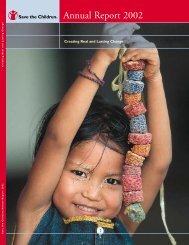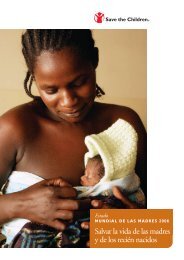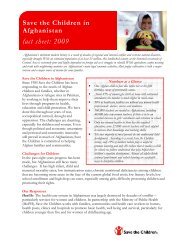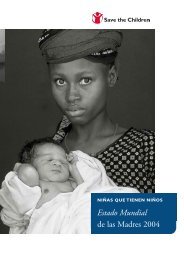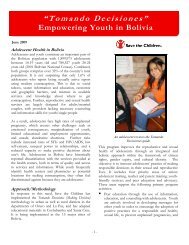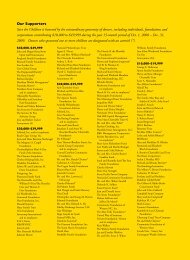The Power and Promise of Girls' Education - Save the Children
The Power and Promise of Girls' Education - Save the Children
The Power and Promise of Girls' Education - Save the Children
Create successful ePaper yourself
Turn your PDF publications into a flip-book with our unique Google optimized e-Paper software.
Fulfilling Her Dream <strong>of</strong> an <strong>Education</strong><br />
Om Kalsoum was an illiterate 14-year-old girl from <strong>the</strong> rural village <strong>of</strong> Daqouf in Upper Egypt<br />
when she joined <strong>Save</strong> <strong>the</strong> <strong>Children</strong>’s Ishraq program in 2001. Her parents didn’t believe in girls’<br />
education <strong>and</strong> refused to enroll Om Kalsoum <strong>and</strong> her sisters at <strong>the</strong> local school.“I used to cry<br />
when I saw <strong>the</strong> girls walking to school in <strong>the</strong>ir uniforms. I wished I could be like <strong>the</strong>m,” she says.<br />
“My biggest dream in life was to become educated.”<br />
Ishraq, meaning “sunrise” in Arabic, gives rural adolescent girls a safe place to socialize with <strong>the</strong>ir<br />
peers as <strong>the</strong>y learn about life skills <strong>and</strong> gain self-confidence. <strong>The</strong> program combines literacy, sports<br />
<strong>and</strong> health education to prepare disadvantaged rural girls to make informed, positive decisions<br />
about issues such as schooling, marriage, family size <strong>and</strong> careers.<br />
Om Kalsoum was elated when she heard that <strong>the</strong> new girls’ education program was being started<br />
in her village.An uncle, who was a member <strong>of</strong> <strong>the</strong> project committee, convinced her parents <strong>of</strong> <strong>the</strong><br />
importance <strong>of</strong> education for girls <strong>and</strong> enrolled her in <strong>the</strong> program. So Om Kalsoum, who normally<br />
only left <strong>the</strong> house to visit relatives, began going to <strong>the</strong> youth center, where she <strong>and</strong> her peers<br />
learned to read <strong>and</strong> write, <strong>and</strong> were presented with topics relevant to <strong>the</strong>ir own lives <strong>and</strong> health.<br />
Om Kalsoum flourished in <strong>the</strong> program <strong>and</strong> went on to pass <strong>the</strong> adult educational examination.<br />
Today, she is continuing her studies <strong>and</strong> talks enthusiastically about her dreams <strong>of</strong> becoming an<br />
Arabic teacher <strong>and</strong> exp<strong>and</strong>ing a bakery she opened using business skills she learned through Ishraq.<br />
Om Kalsoum has convinced her family to postpone her marriage until she completes high school<br />
<strong>and</strong> she talks confidently <strong>of</strong> her ability to be a good mo<strong>the</strong>r.“I want only two children so that I can<br />
be sure to provide <strong>the</strong>m with everything <strong>the</strong>y need, especially a good education.”<br />
Om Kalsoum attended a<br />
“second chance” program<br />
for teenage girls who missed<br />
out on schooling. She now<br />
knows how to read <strong>and</strong><br />
write <strong>and</strong> is running a<br />
successful bakery.<br />
primary education for children because <strong>of</strong> <strong>the</strong> crucial<br />
contributions that children – especially girls – make to<br />
household income <strong>and</strong> livelihood. Families participating<br />
in <strong>the</strong> program received varying quantities <strong>of</strong> wheat <strong>and</strong><br />
rice, depending on <strong>the</strong> number <strong>of</strong> children enrolled in<br />
school. <strong>Children</strong> were required to attend school at least<br />
85 percent <strong>of</strong> <strong>the</strong> time in order for families to receive<br />
<strong>the</strong> food.As <strong>of</strong> 2001, <strong>the</strong> program covered about 27<br />
percent <strong>of</strong> all primary schools <strong>and</strong> provided benefits to<br />
about 13 percent <strong>of</strong> all students enrolled. <strong>The</strong> program<br />
serves both government <strong>and</strong> non-governmental primary<br />
schools.<br />
A study conducted by <strong>the</strong> International Food Policy<br />
Research Institute found that over a two-year period,<br />
children who participated in <strong>the</strong> Food for <strong>Education</strong><br />
program increased overall enrollment rates by 35<br />
percent <strong>and</strong> increased female enrollments by 44 percent.<br />
In addition, <strong>the</strong> study noted <strong>the</strong> critical links between<br />
nutritional status <strong>and</strong> learning potential <strong>and</strong> documented<br />
improved nutrition <strong>and</strong> health among all children <strong>of</strong><br />
participating families, including pre-schoolers. 55<br />
Bangladesh also launched a stipend program in 1994 that<br />
has produced dramatic increases in <strong>the</strong> number <strong>of</strong> girls<br />
in secondary school. <strong>The</strong> project reaches out to <strong>the</strong><br />
poorest families <strong>and</strong> gives <strong>the</strong>m an incentive to keep<br />
girls in school. Stipends, available to girls as <strong>the</strong>y progress<br />
from grades 6 to 10, cover tuition, examination costs,<br />
<strong>and</strong> a portion <strong>of</strong> school fees, textbooks, school supplies,<br />
uniforms, shoes, transport <strong>and</strong> kerosene (for lamps).<br />
<strong>The</strong> program is increasing <strong>the</strong> number <strong>of</strong> secondary<br />
education teachers, particularly females; providing<br />
occupational skills training to girls who are about to<br />
graduate; making schools more attractive to girls by<br />
providing healthier <strong>and</strong> safer settings; <strong>and</strong> streng<strong>the</strong>ning<br />
government institutions for secondary education. One<br />
important outcome <strong>of</strong> <strong>the</strong> stipend program is a drop in<br />
<strong>the</strong> number <strong>of</strong> teenage marriages. 56<br />
As a result <strong>of</strong> all <strong>the</strong>se efforts combined, <strong>the</strong> net primary<br />
enrollment rate in Bangladesh rose from 64 percent in<br />
1990 to 87 percent in 2001. In <strong>the</strong> years 2000 <strong>and</strong> 2001,<br />
<strong>the</strong> gender gap was tipped slightly in favor <strong>of</strong> girls at 102<br />
percent. For <strong>the</strong> same year, <strong>the</strong> net enrollment rate for<br />
girls in primary school reached 88 percent. 57 Bangladesh<br />
is also doing well when it comes to family planning.With<br />
43 percent <strong>of</strong> women using modern contraception,<br />
Bangladesh ranks in <strong>the</strong> top third among developing<br />
countries on this indicator. (See <strong>the</strong> Complete Mo<strong>the</strong>rs’<br />
Index, Appendix B.)<br />
Case in point – Egypt<br />
<strong>The</strong> education system in Egypt is <strong>the</strong> largest in <strong>the</strong><br />
Middle East <strong>and</strong> North Africa <strong>and</strong> among <strong>the</strong> largest in<br />
<strong>the</strong> world.With <strong>the</strong> help <strong>of</strong> international donors, <strong>the</strong><br />
government <strong>of</strong> Egypt made significant investments in<br />
education in <strong>the</strong> 1980s <strong>and</strong> 1990s through initiatives<br />
geared mainly at improving coverage in rural areas. 58<br />
26<br />
THE POWER AND PROMISE OF GIRLS’ EDUCATION




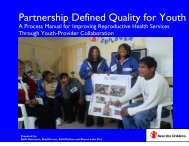

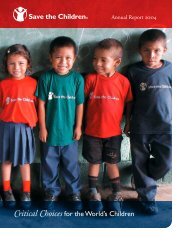
![View full document [PDF 3.39 MB] - PreventionWeb](https://img.yumpu.com/27308954/1/190x245/view-full-document-pdf-339-mb-preventionweb.jpg?quality=85)
